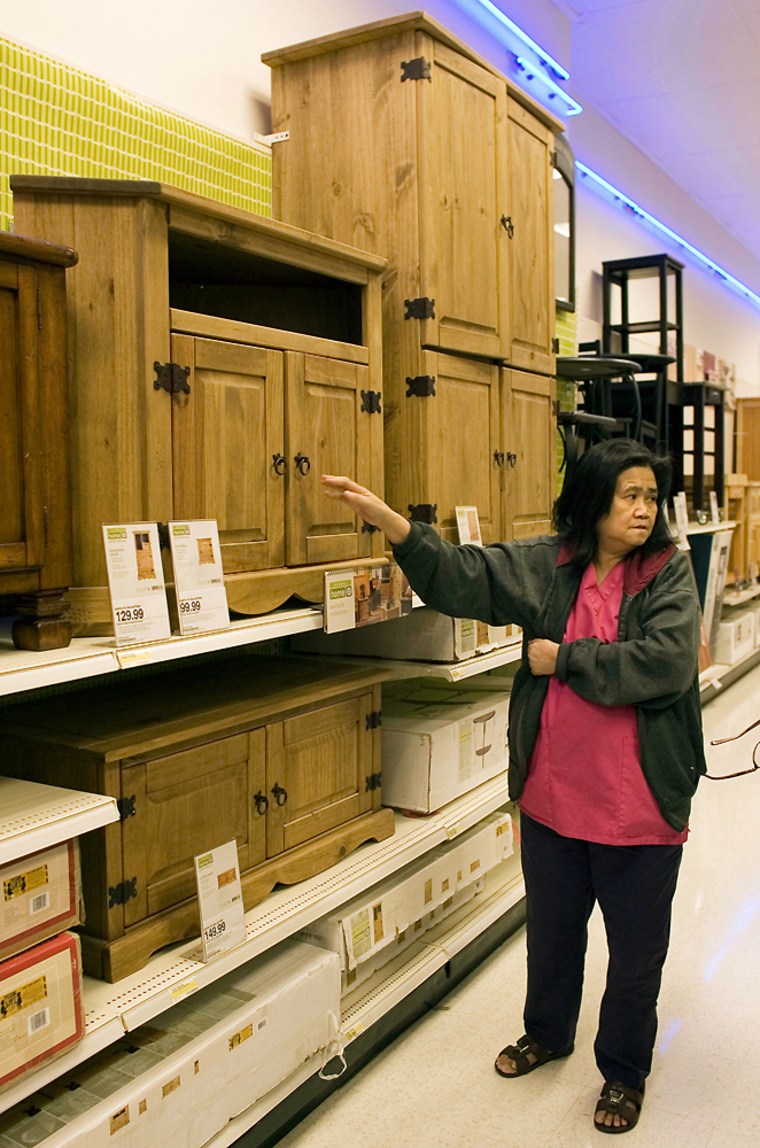The slim tunics and velvet blazers on Wal-Mart’s clothing racks this holiday season are more than the latest trendy fashions — they’re a sign that the intense competition between the world’s largest retailer and its upscale discount rival is ratcheting higher.
There are other indications that Target Corp. has put pressure on Wal-Mart Stores Inc. Hoping to get customers shopping earlier, Wal-Mart will open its doors at 5 a.m. Friday, the official start of the holiday shopping season; that’s an hour earlier than during past holiday seasons. It’s also promising to match competitors’ prices on specific merchandise that day.
“This is the most aggressive Wal-Mart I have seen in 10 years,” said C. Britt Beemer, chairman of America’s Research Group, based in Charleston, S.C. “Target is definitely going to have to be more promotional. It needs to respond.”
Wal-Mart stumbled last holiday season when its discounts weren’t big enough to satisfy customers and its stores lacked must-have items including iPod music players. So far this year, it looks like Wal-Mart has gained ground — this time it’s Target that’s been less generous with discounts, charging more on toys than Wal-Mart and Toys R Us Inc., according to Sean McGowan, an analyst at Harris Nesbitt. And Wal-Mart began promoting holiday merchandise a week earlier than Target.
Wal-Mart’s more aggressive marketing may already have stolen some business from Target, which warned that sales from stores open at least a year, known as same-store sales, are tracking well below its 4 percent to 6 percent growth forecast for November. Same-store sales are considered a strong indicator of a retailer’s health. Wal-Mart has held to its November sales growth forecast of 3 percent to 5 percent.

“Overall, things are changing,” said Gail Lavielle, a Wal-Mart spokeswoman. “We have to be relevant to a broad range of customers. Price is important, but we are also concerned with value. Value is not just price. It is assortment and convenience.”
The early positive signs from Wal-Mart are a welcome turn for the retailer, which has been under increasing criticism for how it treats its workers. But Target appears to be unfazed.
“We feel we will be absolutely competitive with Wal-Mart and the rest of our competitors,” said Lena Michaud, a Target spokeswoman. “Our marketing is just starting.”
Target, whose stores will open at 6 a.m. on Friday, is reprising one of last year’s marketing gimmicks, a wakeup call to shoppers that they can arrange in advance. This year, it’s also adding tuck-in calls, which customers receive the night before the big shopping day.
Target’s early stumble is surprising since the retailer has enjoyed a robust 6.2 percent increase in same-store sales so far this fiscal year, surpassing Wal-Mart’s modest 3.6 percent gain. Target, the No. 2 discounter whose affordable but trendy fashions appeal to a higher-income shopper, has been less vulnerable than Wal-Mart to economic woes such as higher energy prices; Wal-Mart’s core customer is from the lower-income brackets.
But Target faces tough competition from Wal-Mart on more than just price. Wal-Mart has sharpened its merchandise selections in hopes of reaching out to its more style-conscious customers who’ll go to Wal-Mart for food and basics, but avoid the fashion and home furnishings departments. One new attraction is Wal-Mart’s new brand called Metro 7, which offers such designs as low-priced velvet jackets and camisole tops. Shoppers will also see more luxurious linens and a broader array of consumer electronics items that includes higher-end plasma TVs and digital cameras.
Wal-Mart is using its Web site, walmart.com, which sells exclusive, higher-priced products, to reach out to its more affluent shoppers. At the high end, there are $9,988 diamond rings and $1,200 flat-screen TVs with built-in DVD players, but there are also cutting-edge affordable gadgets like $100 pink cube-shaped MP3 players.
Shoppers have noticed the changes.
“They’re getting better,” said Maribel Santiago, shopping at a Wal-Mart supercenter in Wallingford, Conn.
Still, plenty of consumers still look to Target as the place to get cool merchandise. While Wal-Mart has made improvements in its women’s fashions and electronics selection, its home furnishings and men’s apparel still lack excitement, according to Bob Buchanan, a retail analyst at St. Louis-based A.G. Edwards.
“They (Target) represent the fashion and where it is going toward now, more than Wal-Mart,” said shopper Tamara Koch at the Target store in Durham, N.C.
Moreover, Wal-Mart struggles with poor customer service and stores, particularly its older ones, that look tired and unkempt. Target’s stores are brighter and easier to shop.
Judy Klopp, of New Britain, Conn., said of Target employees, “if you’re looking for something, they’ll take you to the right spot. I can’t stand Wal-Mart. You stand in line too long to check out. It’s not clean at all.”
Analysts are also watching to see if ongoing negative publicity about Wal-Mart could turn shoppers away this holiday season. The company has long been criticized for its employment policies, including its wages and health care coverage. Last month, an internal memo, written by a company benefits executive and obtained by an anti-Wal-Mart group called Wal-Mart Watch stirred controversy because it suggested ways to cut soaring medical costs by discouraging unhealthy job applicants.
What could make things worse is a scathing documentary called “Wal-Mart: The High Cost of Low Prices,” which went to a week of screenings in mid-month at 7,000 locations including churches, homes and libraries across the country organized by Wal-Mart critics.
Some consumers said the publicity has influenced where they shop.
“I never go to Wal-Mart,” said Vivian Naimoli of Meriden, Conn., shopping at a local Target. “I just don’t like their philosophy. They seem to put a lot of small guys out of business.”
Wal-Mart had some more bad news recently. According to two union-commissioned university studies, the retailer charged the wrong price to shoppers in California and the Midwest at a rate that exceeds those set by federal guidelines.
Wal-Mart is hoping its changing product mix and lower prices will overcome the negative publicity.
“We hope if we take care of our customers by giving them the best value in the marketplace, they will continue to come to us as a primary destination,” said Lavielle. “We don’t think they will be disappointed.”
